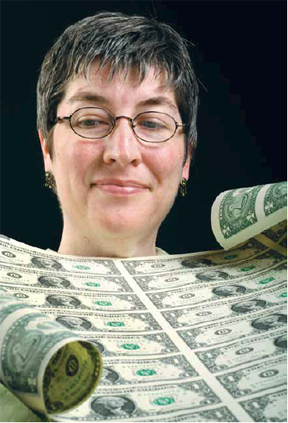
Changes are coming to US currency, thanks in part to recommendations by Liz Holm, a Sandia scientist with expertise in how various materials function.
Liz, a DMTS in Computational Materials Science and Engineering Dept. 1814, was part of a group that helped identify potential new currency features that will use 21st-century materials and technology to help deter counterfeiting.
The goal of the group’s work was to identify and evaluate significant emerging counterfeiting threats against Federal Reserve notes and recommend technologically feasible counterfeit deterrent features for use in future currency.
For the past two years, Liz served on a National Academies committee to study and report on technologies to deter currency counterfeiting. She joined a national panel of scientists and engineers in a series of meetings and site visits in Washington, D.C., and around the country. The committee, sponsored by the National Research Council’s Board on Manufacturing and Engineering Design at the request of the Treasury Department, gathered data on both the counterfeiting threat and possible solutions.
The report was recently released by the National Academies.
The previous National Academies report on this topic led the Treasury Department to redesign currency in the 1990s, adding color, changing the portraiture, and including a watermark and security thread.
A unique service in the national interest
Liz used her expertise in materials science to contribute to the study. For the past 15 years at Sandia, she has worked on computer simulations to understand the behavior of materials in a variety of applications, including advanced lighting, prediction of microcircuit aging and reliability, and the processing of innovative bearing steels. The underlying thrust of her work has been to understand how a material behaves when it performs its job, she says.
Studying technologies and concepts to help deter counterfeiting threats brings her research into the national spotlight.
“Not only is this topic something that resonates with a lot of people,” Liz says, “but it was also a unique kind of service in the national interest.”
Next-generation currency
The committee submitted several recommendations in two categories to the Department of the Treasury: Features in the first category could be fully developed and ready for incorporation in a banknote within seven years, while features in the second category would likely require longer than that. The second category includes revolutionary options that would dramatically shift currency away from the ink-on-paper paradigm of the past 200 years.
The committee suggested 16 changes that could be incorporated in new currency within the next seven years. Since the current counterfeiting threat centers on digital reproduction of paper money using scanners and inkjet printers, these suggestions focus on features that can’t be successfully scanned. The ideas included the possibility of altering the feel of the bill (including analog printed patterns that create artifacts when digitally reproduced) adding a see-through registration feature, and incorporating holograms and visual effects. Patterns using metametric ink, designed to appear the same color under a particular illumination, could be used to change the color of the money in different lighting conditions. Adding a pattern of small holes in the paper using a laser, called microperforation, could also be done.
Genetically engineered cotton, twinkling eyes
Nanotechnology offers some counterfeit protection concepts that would be difficult for the casual counterfeiter to duplicate, Liz says. For instance, nanocrystal pigments could be used to provide unique color and spectral characteristics in an ink format that could be used to form images on the currency. Nanoscale printing techniques could produce printed text, images, or regular arrays of patterns at the micron and submicron range.
Long-term features include bills created from genetically engineered cotton, and solar chips implanted in bills to power electronic features — like a twinkling eye in a bill’s portrait.
“It’ll be exciting to see what changes are incorporated in future notes based on the recommendations the committee provided,” Liz says. “Many of the recommendations may show up in the newly created $100 bill due out in the next few years.”